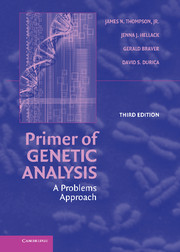Book contents
- Frontmatter
- Contents
- Preface
- Note on Genetic Symbols
- 1 Overview of Genetic Organization and Scale
- 2 Mitosis and Meiosis
- 3 Nucleic Acids: DNA and RNA
- 4 Basic Mendelian Genetics
- 5 Probability and Chi-Square
- 6 Sex-Linkage and Gene Interactions
- 7 Pedigree Analysis
- 8 Overview of Basic Statistical Testing
- 9 Quantitative Inheritance
- 10 Overview of Genetic Mapping
- 11 Assessing Chromosome Linkage Relationships
- 12 Linkage and Mapping in Diploids
- 13 Mapping in Bacteria and Viruses
- 14 Overview of Types of Genetic Change
- 15 Gene Mutation
- 16 Changes in Chromosome Number and Structure
- 17 Protein Synthesis and the Genetic Code
- 18 Gene Regulation and Development
- 19 Overview of Molecular Biology Techniques
- 20 DNA Mapping and Human Genome Analysis
- 21 Basic Population Genetics
- 22 Selection and Evolution
- 23 Practice Tests
- 24 Answers to Practice Tests and Crossword Puzzles
- 25 Landmarks in the History of Genetics
- Glossary
- Reference Tables
4 - Basic Mendelian Genetics
Published online by Cambridge University Press: 05 June 2012
- Frontmatter
- Contents
- Preface
- Note on Genetic Symbols
- 1 Overview of Genetic Organization and Scale
- 2 Mitosis and Meiosis
- 3 Nucleic Acids: DNA and RNA
- 4 Basic Mendelian Genetics
- 5 Probability and Chi-Square
- 6 Sex-Linkage and Gene Interactions
- 7 Pedigree Analysis
- 8 Overview of Basic Statistical Testing
- 9 Quantitative Inheritance
- 10 Overview of Genetic Mapping
- 11 Assessing Chromosome Linkage Relationships
- 12 Linkage and Mapping in Diploids
- 13 Mapping in Bacteria and Viruses
- 14 Overview of Types of Genetic Change
- 15 Gene Mutation
- 16 Changes in Chromosome Number and Structure
- 17 Protein Synthesis and the Genetic Code
- 18 Gene Regulation and Development
- 19 Overview of Molecular Biology Techniques
- 20 DNA Mapping and Human Genome Analysis
- 21 Basic Population Genetics
- 22 Selection and Evolution
- 23 Practice Tests
- 24 Answers to Practice Tests and Crossword Puzzles
- 25 Landmarks in the History of Genetics
- Glossary
- Reference Tables
Summary
STUDY HINTS
Although Mendel did not know about the events that occur in a dividing cell, his laws of segregation and independent assortment are really descriptions of chromosome behavior during meiosis. Segregation simply refers to the fact that the two homologous chromosomes separate to opposite sides of the cell (that is, they segregate) after synapsis in the first meiotic division. Independent assortment reflects the fact that the orientation of one pair of homologous chromosomes at the equatorial plate in cell division is independent of the orientation of other pairs; that is, alignment of chromosomes occurs randomly relative to one another.
The secret to solving Mendelian genetics questions is to recognize that there is a pattern hidden within the superficial confusion of facts with which you are presented. The first important step is to have a clear understanding of mitosis and meiosis. Then you must have a thorough working knowledge of the terminology. Beginning students commonly confuse phenotype and genotype, or gene and allele. Genotype is the genetic makeup (such as Aa), whereas phenotype is the expression of the genotype interacting with its environment (such as brown versus black fur). Different genes code for totally different protein products (such as a pigment enzyme versus blood membrane protein), whereas alleles are the different forms that a specific gene can have (such as normal enzyme A versus the lower-activity form of the same enzyme a).
- Type
- Chapter
- Information
- Primer of Genetic AnalysisA Problems Approach, pp. 28 - 41Publisher: Cambridge University PressPrint publication year: 2007

